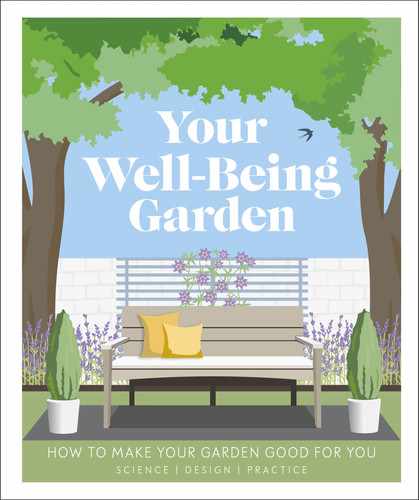
171
170
THESUSTAINABLEGARDEN
There are a number of dierent types of green
walls. A self-attaching climber planted in the
ground or in a planter is known as direct
greening. A climber trained on a trellis or wire is
known as indirect greening. A living wall system
has pockets or planter boxes installed on the
wall to support a selection of plants that are not
necessarily climbers.
Greening up the walls
The easiest and cheapest way to make a
green wall is simply to plant a climber or wall
shrub next to a wall. You could also consider
training a fruit tree as an espalier or fan against
a wall (see pp.156–157). Attaching wires or trellis
to the wall for climbers to use creates a gap of
insulating air between the plants and the
building. If you want to cover an entire exterior
wall, you may need professional help with the
installation of supports.
Living wall art
Living wall systems are an exciting way to
green up buildings. They range from simple
fabric planters that you can attach to a frame
or directly to a wall and ll with plants, to large
modular systems connected to a drip-irrigation
system that usually have to be installed by
a professional.
Living wall systems can support a selection
of dierent plants, such as ferns, grasses, herbs,
annuals, perennials, fruit, and vegetables. You
can use your creativity to arrange them in eye-
catching displays of living art.
GREENWALL
INSULATION
For balconies and smaller areas, rows of pockets
or modules that can be attached to the wall are
ideal. Fill these with potting soil for an
inexpensive and space-saving way of growing
ornamentals and edible plants. Unless you
have space to install a drip-irrigation system,
you will need to water by hand, so choose plants
that have similar requirements to make
watering simpler.
Professional installers construct engineered
systems in layers. They attach irrigated planting
modules to a frame that is separated from the
building with an air gap and geotextile
membrane, trapping pockets of warmer air in
winter. Some suppliers now oer modules
planted specically to attract pollinating insects.
Interior green walls are also a good option.
Modular walls tted with water reservoirs to
reduce their maintenance requirements are
becoming more widely available. Your choice of
plants will depend on the amount of light and
heat exposure they will experience.
In winter, a living wall
can reduce a building’s
heating demands
by 4 percent
US_170-171_Green_Insulation.indd 170 13/11/2019 15:34

171
170
THE SUSTAINABLE GARDEN
Plant sun-loving species near the top of
your wall, with shade-tolerant ones at the
base. If your wall gets sun for less than
half the day, choose plants for shade.
SAVE ENERGY WITH PLANTS
US_170-171_Green_Insulation.indd 171 13/11/2019 15:34

172
173
Green roofs are a great way to soften
hard edges, blending buildings
seamlessly into the garden. They will
also attenuate rainwater runo and
provide natural insulation from above.
Jasmine directed
up a row of
vertical supports
creates a
delicate curtain
and lls the
summer air with
its gorgeous
fragrance
I planted a small pine
to add structure to this
part of the garden,
and to help cool the
building and the
garden with the
shade it casts
I used a rooftop carpet of
stonecrops (Sedum) to help
to conceal the structure
US_172-173_Matt_Garden_Room.indd 172 13/11/2019 15:35
..................Content has been hidden....................
You can't read the all page of ebook, please click here login for view all page.
